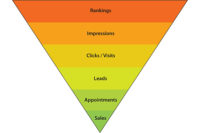
|
| Ben Landers |
Virtually every HVAC contractor understands the importance of having a website, but many treat their websites as if they are digital brochures. Brochures don’t close sales; people close sales. If you want to grow your business, you need to change the way you think about your website. Your website is not a brochure; it’s a sales rep.
A well-designed and optimized website has the power to transform your business by generating hundreds — even thousands — of qualified leads per month. But, you’ll never achieve this kind of success unless you become intimately familiar with your website’s key performance metrics.
Visit-to-Lead Conversion Rates
Let’s start with one of the most frequently overlooked, yet most important, website metrics — your visit-to-lead conversion rate.
An awful lot of contractors spend a significant amount of time and/or money on pay-per-click advertising, search engine optimization (SEO), and social media with the intention of getting more visitors to their website(s). However, very few spend even a penny or a single minute accurately assessing exactly how many of those new visitors are actually turning into leads and sales.
This leads me (no pun intended) to a key point: If you’re a residential HVAC contractor and your website’s visit-to-lead conversion rate is less than 14 percent, you may be throwing your marketing dollars out the window. Would you spend money to generate leads for a sales rep that can’t close the deal? I wouldn’t and you probably wouldn’t either. Why act any differently when it comes to your online marketing and your website?
Tracking Visit-to-Lead Conversion Rate
Hopefully, I’ve piqued your interest and you’re wondering what your number is and how you go about tracking it. The good news is it’s not terribly difficult — you just need a few basic website tracking tools (or light customizations to those you may already have in place).
Step 1: Customize Google Analytics
The first thing you have to do, if you want to accurately track your website’s visit-to-lead conversion rate, is install and/or customize Google Analytics to track the number of people that complete your online appointment request forms. In Google Analytics, this is called goal or conversion tracking. If you’ve opted to place email addresses throughout your site, in addition or in place of online appointment request forms, I recommend you remove them. You can use Google Analytics to track the number of people that contact you via email addresses listed on your website, but it’s much more difficult and far less accurate.
If you already have website contact forms that capture visitor contact information (e.g. Request An Appointment or Contact Us Now, etc.), the easiest way to track these in Google Analytics is to define a unique thank you page that visitors reach after they complete a form. With this special thank you page created, you go into Google Analytics and create a conversion goal for each time a visitor reaches your thank you page.
While you’re in your Google Analytics account, there’s another change you should make. One mistake frequently made by local contractors is not excluding visitors to their website from outside their service area. Your visit-to-lead conversion rate is a measure of your website’s effectiveness at turning visitors into leads, but should your website really be expected to close the deal with a visitor on your website when the visitor is in India? Of course not.
If you’re an HVAC contractor servicing a defined geographic area, like the Greater Denver area, you are also going to want to create what Google calls an Advanced Segment to show only those people visiting your website from within your service area.
Step 2: Install Call Tracking
A typical residential HVAC dealer/contractor will receive five phone calls from his website for every Web form received. Think about that for a minute because this ratio has some powerful implications. Almost every contractor has Google Analytics installed on his website, which is great, but, if you’re only making decisions based on the Web leads you receive, you’re missing more than half the picture (read this again). For those of you doing this, let’s take a minute to be thankful that you’re operating on people’s heating and cooling systems and not their hips and knees.
If you receive appointment requests in the form of phone calls, you’re going to want to invest in a call-tracking system to track phone calls from your website separately. A good call-tracking platform will not only allow you to determine your visit-to-lead conversion rate, but it will also show you the calls, leads, and sales you get from all your website traffic sources such as Google, Bing, and even Facebook. Is social media really all that it’s cracked up to be? With call tracking and customizations to your Google Analytics account, you can find out.
Putting it all Together
Most HVAC contractors focus on increasing traffic, but you can’t pay your bills with website visitors. If you want to get more leads and sales from the Web, you need to focus on metrics other than visits. A good place to start is with your visit-to-lead conversion rate. By accurately tracking your site’s visit-to-lead conversion rate across various Web traffic sources, you can answer tough marketing questions that stump your competitors — questions such as, “Is pay-per-click advertising worth it,” and “How much should I invest in SEO”?
Your website is your single-most valuable marketing asset. Don’t think of it like a brochure; treat it like a virtual sales rep. Sales reps thrive when they are given goals and held accountable for producing results. Your website is no different. You can’t hold your website accountable or maximize your site’s performance if you don’t know your key metrics.
Like a great sales rep, your website can help you grow your business in ways you never imagined possible. Unlike a real sales rep, your website works 24/7 and will never ask you for a day off, a raise, or leave you for a competitor.
Publication date: 11/4/2013
Want more HVAC industry news and information? Join The NEWS on Facebook, Twitter, and LinkedIn today!








